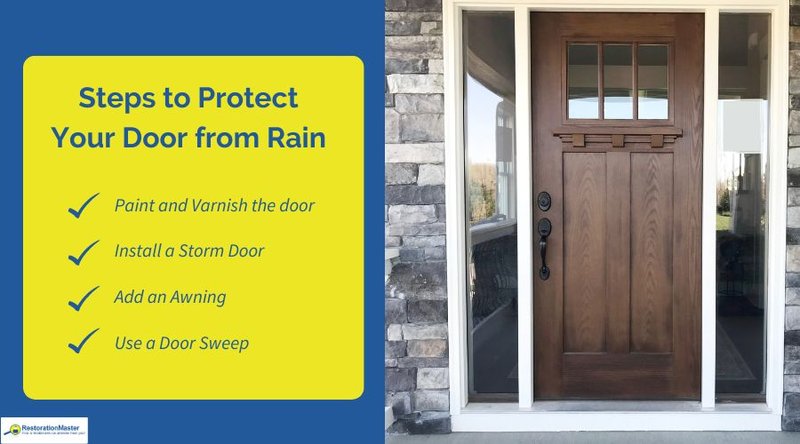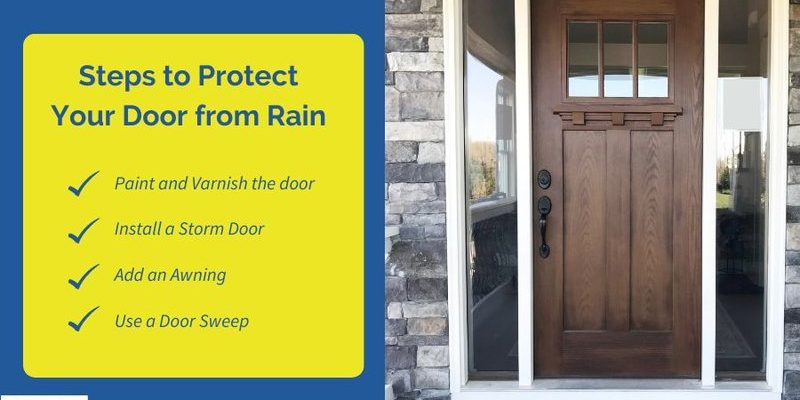
Think of it like parking your car outside year-round with no garage. Pretty soon, all that weather starts to leave a mark. Door hardware is tough, but after a few seasons of rain, you might notice it gets sticky, starts to rust, or just looks dingy no matter how much you clean it. Brands like Schlage, Kwikset, and Yale all make solid locks and handles, but even the best gear needs some backup when the clouds roll in. So if you want your door hardware to last and keep working smoothly—without shelter above—it’s time to think smart about protection.
Pick Weather-Resistant Hardware for Rain-Prone Doors
Start with the gear itself. Not all door hardware is ready for the rain, especially if your door doesn’t have an overhang. Some materials love to rust, pit, or degrade when water’s involved, while others practically laugh in the face of storms. Weather-resistant hardware, usually made from stainless steel, brass, or treated zinc alloys, is designed to keep going even when things get soggy.
You might be wondering why anyone would choose regular hardware for an exposed door. Sometimes it’s about style, availability, or price. But trust me: if rain is a factor, upgrade now, not after you’re fighting to open a rusty lock. Look for brands that specifically call out rain resistance, marine-grade finishes, or “exterior use” on the box. For smart locks or remotes (think Schlage Encode or Yale Assure), make sure seals and keypads are rated for outdoor exposure—not just “indoor/outdoor,” but truly weatherproof.
It’s not just about the lock, either. Hinges, strike plates, and even the mounting screws are vulnerable. Stainless steel screws might not sound like a big deal, but they’re less likely to corrode or snap off a year later. If water finds even a tiny weak spot, that’s where trouble starts. Think of it as building your storm team: everyone needs to be on the same page.
Apply Protective Coatings for Extra Defense
Let me explain this: even the best hardware materials get by with a little help from modern science. Protective coatings can add a shield against water, salt, and everything else Mother Nature throws around. We’re talking clear sprays, wax-based polishes, and special finishes designed for metal surfaces—like car wax, but for your front door.
You might feel skeptical about “just spraying something on,” but quality coatings work. Try a silicone-based lubricant on locks and hinges to keep water out and mechanisms moving smoothly. For larger surfaces, automotive wax or clear lacquer sprays add a water-repellent layer that keeps hardware clean and shiny. Don’t use oil-based sprays like WD-40 for long-term weather protection—they attract grime and eventually wear off.
Always clean hardware first—otherwise, you’re locking in water or dirt. Wipe everything dry, then apply your chosen coating every few months, especially after heavy storms. It’s a small job that pays off big when you’re not replacing a crusty, stuck deadbolt every spring.
Seal Door Edges and Gaps to Stop Water Intrusion
If water’s getting in through the sides of the door, not even the best hardware will last. Here’s where weatherstripping comes into play. Even a tiny gap can let water drip down behind or around your hardware, soaking screws and inner workings. Over time, that moisture leads to rust, swelling wood, and locks that are impossible to turn.
Install adhesive-backed foam or rubber weatherstripping around the door frame. For bigger gaps, try door sweeps or thresholds that block water from flowing underneath. A tube of exterior-grade silicone caulk can seal up any cracks between the frame and wall. These fixes aren’t just about energy savings—they genuinely protect your hardware by keeping wetness outside, where it belongs.
You might be tempted to skip this step if your hardware looks fine right now. But honestly, the invisible water is the biggest threat. It creeps in, attacks from behind, and by the time you notice, your lock or handle is already struggling. A few strips of weatherstripping and ten minutes with a caulk gun can save you hours of future repairs.
Use Drip Caps or Shields to Redirect Water
When you can’t put an overhang above your door, a drip cap or shield is the next best thing. These are slim, angled pieces of metal or plastic that install just above the door or directly above the hardware. Their whole job is to guide water away—redirecting rain so it falls harmlessly past your lockset and handle instead of running right over them.
You might think these are only for old houses or utility sheds, but modern versions are subtle enough for stylish front doors, too. Some brands even make hardware with built-in shields, especially for commercial or remote access doors. Just check that your drip cap’s edges extend beyond the hardware, and remember to leave enough space for any electronic keypads or remotes to function properly.
Installation is simple—usually a couple of screws or strong adhesive. It’s not a full roof, but in a heavy downpour, even a one-inch shield can make a surprising difference. You’ll still want to combine this with weather-resistant finishes and regular cleaning. No single fix is perfect, but layering up defenses gives you the best odds.
Keep Up with Regular Maintenance and Cleaning
You might be surprised how much trouble you can avoid by just giving your hardware a regular checkup. Rain brings more than water—it carries dust, grime, bugs, and even acidic residue from pollution. If this stuff builds up, even top-tier brands like Kwikset or Yale can start to jam or corrode, especially on doors that face the elements all day.
Set a reminder to wipe down your door hardware every month or so. Use a soft cloth and a gentle cleaner—nothing abrasive or harsh. For locks and smart remotes, clean the keyway and keypad gently to keep everything responsive. Spray a little silicone lubricant into moving parts a few times a year.
Check for loose screws, wobbly handles, and any early signs of rust. It’s a pain to fix once things fully seize up, so catch problems early. If you use a remote-access deadbolt, replace batteries annually and check for moisture inside the housing—it only takes one rainy season for water to sneak past old seals.
Even the best-protected hardware needs TLC to stay in top shape. Your door is a working machine, not just a decoration. Give it the same love you’d give a car or a favorite tool.
Consider Upgrading to Smart or Remote Hardware Built for Outdoor Use
If you’re already thinking about an upgrade, consider swapping to smart locks or remote systems built specifically for exterior doors. Many of the latest models from Schlage, Yale, and Kwikset offer features like waterproof keypads, sealed battery compartments, and tamper alerts. But don’t just grab any “smart” model—make sure it’s rated for full outdoor exposure.
Here’s the thing: some remote locks are designed for protected patios or garages and aren’t ready for direct, heavy rain. Check the IP (Ingress Protection) rating, and look for terms like “weatherproof,” not just “weather-resistant.” Higher-end models usually include more robust gaskets and finishes, plus better troubleshooting features if things go wrong.
If you ever need to reset, pair, or sync these locks, make sure you’ve got a solid Wi-Fi or Bluetooth connection—rain won’t wreck the signal, but corrosion inside the hardware definitely can. Regularly check the remote’s battery and seals to keep everything running smoothly.
Know When to Replace Hardware That’s Past Its Prime
Sometimes, even with the best care, it’s time to say goodbye. If your hardware is already corroded, jammed, or the finish is flaking away, no amount of cleaning or coating will bring it back to life. This is especially true for bargain locks or handles that weren’t designed for outdoor punishment in the first place.
Replacing outdated hardware with new, rain-ready models is an investment—but it saves headaches and improves security. When choosing replacements, read reviews and look for proof of real-world performance. For smart or remote locks, check if they come with firmware for easy code changes and troubleshooting support. Choose hardware brands and models that let you reset or sync easily, so you’re not stuck in the rain trying to figure things out.
It’s tempting to make do, but in my experience, a fresh start often costs less (in time and frustration) than endless patchwork repairs. Your door is the gateway to your space—don’t let it be the weak point.
Avoid Common Mistakes That Invite Water Damage
Sometimes the biggest risks come from mistakes we don’t even think about. Using interior-only hardware outdoors, skipping the prep work, or believing that “one coat is enough” when applying sealant all let water sneak in. If you’ve ever watched water drip down a wall and pool perfectly around a lock, you know the feeling.
Don’t use screws or fasteners that aren’t rated for exterior use—they’re usually the first parts to fail. Make sure any cutouts for remotes, keypads, or smart locks are sealed tight with gaskets. Avoid painting over moving parts, since that can actually trap moisture and speed up corrosion. And if you notice a loose part or hear grinding when you turn a key, deal with it before the next big storm.
A little foresight saves a lot of hassle. Protecting hardware from heavy rain is about smart choices and steady upkeep, not just luck.
Closing Thoughts: Keeping Door Hardware Safe in the Storm
Living with a rain-battered door isn’t the end of the world, but it does take a little extra care to keep hardware looking great and working right. Whether you lean toward rugged, weatherproof handles or rely on smart remote locks to keep things secure, the main idea is simple: layer your defenses and stay ahead of the weather.
Choose hardware that’s built for tough conditions, protect it with smart coatings, seal every gap, and don’t forget your regular checkups. If you’re investing in a remote or electronic lock, go for brands made for outdoor duty—Schlage, Yale, and Kwikset all have solid outdoor options. And if rain finally wins against your old setup, don’t hesitate to start fresh with new, rain-ready gear.
The payoff? A door that opens easily, stays secure, and doesn’t look like a shipwreck after every storm. Whether you’re coming home with arms full of groceries or heading out in a hurry, you’ll appreciate hardware that stands up to whatever the weather delivers—overhang or no overhang.
